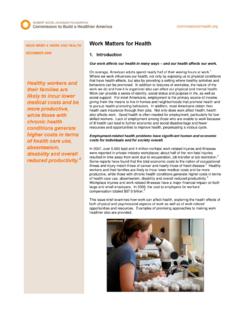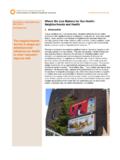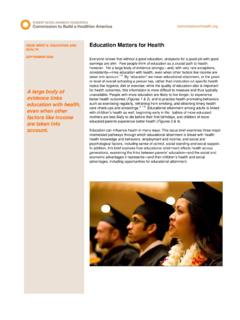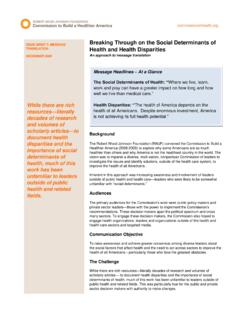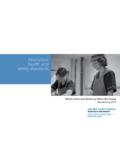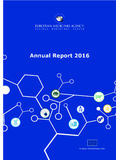Transcription of Housing and Health Issue Brief 10-16-08
1 Issue Brief 2: Housing AND Health SEPTEMBER 2008 Housing affordability Neighborhood conditions Health Conditions within the home Where We Live Matters for Our Health : The Links Between Housing and Health 1. Introduction Where we live is at the very core of our daily lives. For most Americans, home represents a place of safety, security, and shelter, where families come together. Housing generally represents an American family s greatest single expenditure, and, for homeowners, their most significant source of wealth. Given its importance, it is not surprising that factors related to Housing have the potential to help or harm our Health in major ways. This Issue Brief examines the many ways in which Housing can influence Health and discusses promising strategies to improve America s Health by ensuring that all Americans have healthier homes. The focus is on three important and inter-related aspects of residential Housing and their links to Health : the physical conditions within homes; conditions in the neighborhoods surrounding homes; and Housing affordability, which not only shapes home and neighborhood conditions but also affects the overall ability of families to make healthy choices.
2 A companion Brief examines neighborhoods and Health in more depth than possible here: Figure 1. Housing influences Health in many ways. Most Americans spend about 90% of their time indoors, and an estimated two-thirds of that time is spent in the home. 1 Very young children spend even more time at home 2 and are especially vulnerable to household hazards. Page 2 2. Housing conditions and Health Good physical and mental Health depends on having homes that are safe and free from physical hazards. When adequate Housing protects individuals and families from harmful exposures and provides them with a sense of privacy, security, stability, and control, it can make important contributions to Health . In contrast, poor quality and inadequate Housing contributes to Health problems such as infectious and chronic diseases, injuries, and poor childhood development. 3, 4 For example: Lead poisoning irreversibly affects brain and nervous system development, resulting in lower intelligence and reading disabilities.
3 An estimated 310,000 children ages one to five have elevated blood lead Most lead exposures occur in the home, particularly in homes built before 1978 that often contain lead-based paint and lead in the plumbing systems. Deteriorating paint in older homes is the primary source of lead exposure for children, who ingest paint chips and inhale lead-contaminated dust. Between 1998 and 2000, a quarter of the nation s Housing 24 million homes was estimated to have significant lead-based paint hazards. 6 Substandard Housing conditions such as water leaks, poor ventilation, dirty carpets and pest infestation can lead to an increase in mold, mites and other allergens associated with poor Health . Indoor allergens and damp Housing conditions play an important role in the development and exacerbation of respiratory conditions including asthma, which currently affects over 20 million Americans 7, 8 and is the most common chronic disease among children.
4 Approximately forty percent of diagnosed asthma among children is believed to be attributable to residential exposures. 9, 10 In 2004, the cost of preventable hospitalizations for asthma was $ billion, a 30 percent increase from Exposure to very high or very low indoor temperatures can be detrimental to Health . Cold indoor conditions have been associated with poorer Health , including an increased risk of cardiovascular disease. 3 Extreme low and high temperatures have been associated with increased mortality, especially among vulnerable populations such as the Housing can be a source of exposure to various carcinogenic air pollutants. Radon, a natural radioactive gas released from the ground, has been associated with lung cancer; an estimated one in 15 homes has elevated radon levels. 12 Residential exposure to environmental tobacco smoke, pollutants from heating and cooking with gas, volatile organic compounds and asbestos have been linked with respiratory illness and some types of Each year, injuries occurring at home result in an estimated 4 million emergency-department visits and 70,000 hospital Contributing factors include structural features of the home such as steep staircases and balconies, lack of safety devices such as window guards and smoke detectors, and substandard heating systems.
5 3, 4 Residential crowding has been linked both with physical illness, including infectious diseases such as tuberculosis and respiratory infections,3, 15 and with psychological distress among both adults and children; children who live in crowded Housing may have poorer cognitive and psychomotor development or be more anxious, socially withdrawn, stressed or aggressive. 16 Healthy homes promote good physical and mental Health . Page 3 Poor indoor air quality, lead paint, lack of home safety devices, and other Housing hazards often coexist in homes, placing children and families at great risk for multiple Health problems. And substandard Housing is much more of a risk for some families than others; Housing quality varies dramatically by social and economic circumstances. Families with fewer financial resources are most likely to experience unhealthy and unsafe Housing conditions and typically are least able to remedy them, contributing to disparities in Health across socioeconomic groups in this country.
6 Examples of public and public-private initiatives to improve physical conditions in homes Healthy People 2010 called for a 52% reduction in the more than six million currently occupied Housing units in the United States with moderate or severe physical problems. Other Housing -related goals include reducing indoor household allergen levels and increasing the proportion of people living in pre-1950 s homes that have been tested for presence of lead Because Housing hazards often coexist in homes, evidence suggests that it may be more cost-effective to combat these home hazards together. While links between Housing deficiencies and Health conditions are well substantiated, research evaluating the Health benefits of specific interventions has been limited. There is, however, some evidence that multifaceted interventions may lead to improvements in children s Health in general and asthma symptoms specifically as well as to reduced use of medical Examples of multifaceted interventions to improve conditions in homes for which some evidence is available include: Healthy Homes Initiative (HHI).
7 Congress established the HHI to develop and implement a program of research and demonstration projects that would address multiple Housing -related problems affecting the Health of children. Begun in 1999, this HUD initiative strives both to identify multiple Housing deficiencies that affect Health , safety and quality of life and to take actions to reduce or eliminate the Health risks related to poor quality Housing . HHI supports interventions (executed through competitively-awarded agreements, contracts with private and public agencies and interagency agreements) in four areas: excess moisture; dust; ventilation and control of toxins; and tenant education in high-risk Housing areas. Approximately $ million was spent on these programs from 1999-2005. 19, 20 Seattle King County Healthy Homes Project (SKCHHP). From 1997-2005, this project, sponsored by the Seattle Partners for Healthy Communities and primarily funded by the National Institute of Environmental Health Science, was developed by a partnership of public and private agencies to improve asthma-related Health status by reducing exposure to allergens and irritants in low-income households of families with asthmatic children.
8 Paraprofessional community home environmental specialists visiting homes over a 12-month period provided a comprehensive set of interventions including a home environmental assessment, individualized action plans, education and social support, and the provision of materials and resources to reduce exposures to allergens. Building on the success of this program, the HUD-funded Seattle Healthy Homes Initiative incorporated remediation of structural lead and injury hazards into the intervention package to address exposures to multiple household , 22 Multiple unhealthy conditions often cluster in homes. Page 4 3. Neighborhood conditions and Health Along with conditions in the home, conditions in the neighborhoods where homes are located also can have powerful effects on The social, physical and economic characteristics of neighborhoods have been increasingly shown to affect short- and long-term Health quality and longevity.
9 A neighborhood s physical characteristics may promote Health by providing safe places for children to play and for adults to exercise that are free from crime, violence and pollution. Access to grocery stores selling fresh produce as well as having fewer neighborhood liquor and convenience stores and fast food outlets can make it easier for families to find and eat healthful foods. Social and economic conditions in neighborhoods may improve Health by affording access to employment opportunities and public resources including efficient transportation, an effective police force, and good schools. Neighborhoods with strong ties and high levels of trust among residents may also strengthen Health . Not all neighborhoods enjoy these opportunities and resources, however, and access to neighborhoods with Health -promoting conditions varies by a household s economic and social resources. Housing discrimination has limited the ability of many low-income and minority families to move to healthy neighborhoods.
10 The concentration of substandard Housing in less advantaged neighborhoods further compounds racial and ethnic as well as socioeconomic disparities in Health . Note: The growing body of evidence of the association between neighborhoods and Health is discussed in a separate Issue Brief and can be found on the Commission website at Living in a disadvantaged neighborhood can limit opportunities for healthy choices, regardless of a family s own level of resources. Page 5 4. Housing affordability and Health The affordability of Housing has clear implications for Health . The shortage of affordable Housing limits families and individuals choices about where they live, often relegating lower-income families to substandard Housing in unsafe, overcrowded neighborhoods with higher rates of poverty and fewer resources for Health promotion ( , parks, bike paths, recreation centers and activities).
